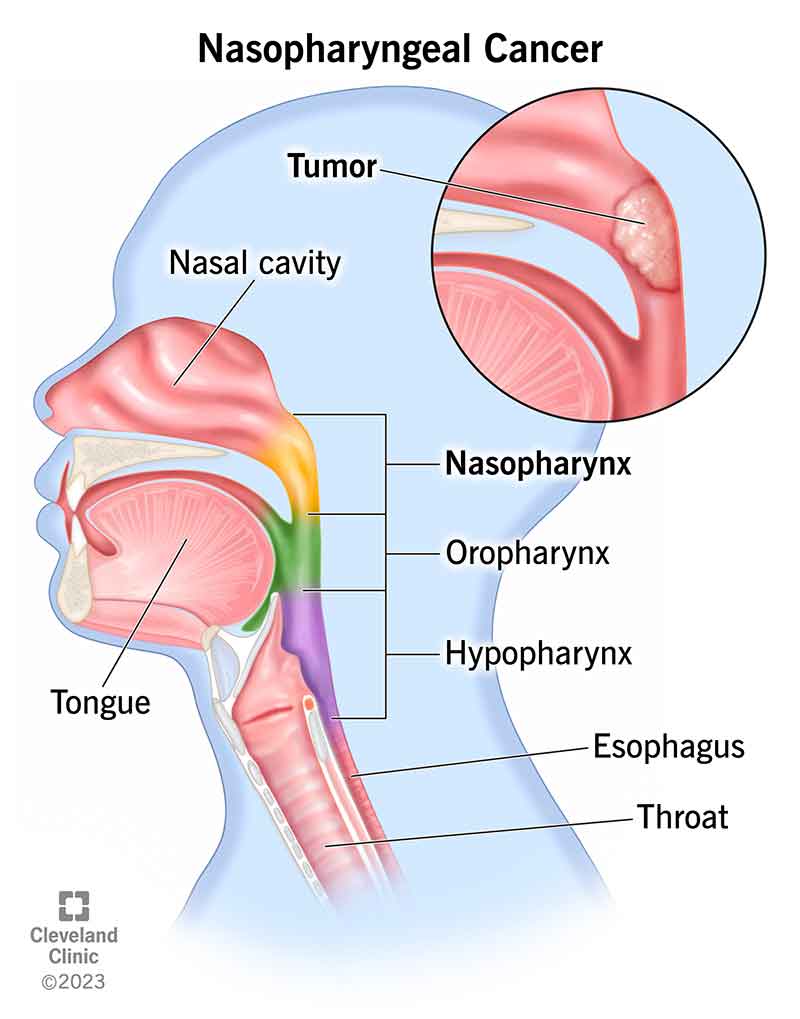Nasopharyngeal cancer is a rare type of cancer that starts in your nasopharynx, the tissue that connects the back of your nose to the back of your mouth. The most common symptom is a painless lump on the back of your neck, but it may also affect your ears, causing hearing loss or chronic ear infections. It can cause facial pain and numbness as well. Specific treatment depends on the stage of cancer.
Advertisement
Cleveland Clinic is a non-profit academic medical center. Advertising on our site helps support our mission. We do not endorse non-Cleveland Clinic products or services. Policy

Nasopharyngeal cancer (NPC), also known as nasopharyngeal carcinoma, is a rare type of head and neck cancer.
Advertisement
Cleveland Clinic is a non-profit academic medical center. Advertising on our site helps support our mission. We do not endorse non-Cleveland Clinic products or services. Policy
It affects the tissue that connects the back of your nose to the back of your mouth. This area is called the nasopharynx, and it’s located just above the roof of your mouth, at the base of your skull. When you breathe in through your nose, air flows through your nose, nasopharynx and into your throat before it reaches your lungs.
Nasopharyngeal cancer begins when abnormal cells in your nasopharynx start to grow out of control and form cancerous tumors that can spread to your lymph nodes, liver, lungs and bones.
There are different kinds of tissue in your nasopharynx, and each kind contains different types of cells. Each cell type looks different when viewed under a microscope. Nasopharyngeal cancer subtypes are classified by the type of cell affected. According to the World Health Organization (WHO), NPC is classified into three subtypes:
Advertisement
It’s rare in the U.S., affecting 1 out of 100,000 people each year. Nasopharyngeal cancer is more common in Asia, North Africa and the Middle East. Nasopharyngeal cancer in the U.S. typically affects people ages 15 to 24 and ages 65 to 79.
In most cases, people with nasopharyngeal cancer notice a lump on the back of their neck. There may be one or multiple lumps, and they’re usually not painful. These masses appear when cancer spreads to the lymph nodes in your neck and causes them to swell.
There are also several other warning signs such as:
Many nasopharyngeal cancer symptoms are like symptoms of other, less serious illnesses. Having one or more of these symptoms doesn’t mean you have nasopharyngeal cancer. But you should talk to a healthcare provider if you have symptoms that last for more than two weeks or they keep coming back.
Experts aren’t exactly sure what causes nasopharyngeal cancer. However, certain lifestyle behaviors and medical conditions can increase your chance of developing the disease, including:
If your healthcare provider thinks that you may have nasopharyngeal cancer, they’ll ask about your family history and do a full physical exam. They’ll examine your nasopharynx, head, neck, mouth, throat, nose, facial muscles and lymph nodes. They may do a hearing test. Other tests may include:
Advertisement
Providers use test results to stage nasopharyngeal cancer. Cancer staging systems help providers plan treatment and estimate prognosis.
Nasopharyngeal cancer staging is determined by several factors, including the size and location of the tumor and how far the cancer cells have spread.
Specific treatment depends on the stage of cancer. Nasopharyngeal cancer treatment may include:
Advertisement
Healthcare providers typically treat nasopharyngeal with radiation therapy or chemotherapy. Radiation and chemotherapy side effects may vary. If you’re being treated for nasopharyngeal cancer, you may want to consider palliative care to help you manage treatment side effects.
NPC can be cured if healthcare providers diagnose the condition before it spreads.
Data kept by the American Cancer Society show 63% of people with nasopharyngeal cancer in the U.S. were alive five years after diagnosis. Like many cancer types, NPC survival rates improve if cancer is diagnosed before it can spread:
Survival rates are estimates based on the experiences of other people who have the same kind of cancer. Many factors affect survival rates, including a person’s age, overall health and how well they respond to treatment.
Advertisement
If you have nasopharyngeal cancer, it’s important to remember that your experience may be different from other people’s experiences. Ask your healthcare provider what you can expect given your situation.
Your healthcare provider can help you find ways to manage your symptoms, relieve pain and improve your overall quality of life. Recommendations often include:
If you’ve been diagnosed with nasopharyngeal cancer, gaining a full understanding of your situation can empower you and help you make informed decisions about your health. Here are some questions to ask your healthcare provider:
Nasopharyngeal cancer is a rare type of head and neck cancer. Experts aren’t sure why it happens, but they believe heavy use of tobacco and beverages containing alcohol increases a person’s risk. They also believe having a biological family history of the condition may play a role. Talk to a healthcare provider if you’re concerned you may be at risk. They’ll evaluate your overall health, assess your risk and suggest ways you can reduce it.
Get compassionate head and neck cancer treatment at Cleveland Clinic. Our providers use the latest tools and research to give you the best possible outcome.

Last reviewed on 09/07/2023.
Learn more about the Health Library and our editorial process.